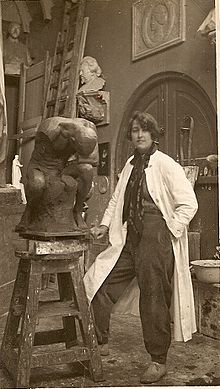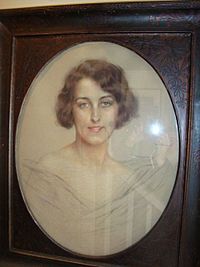C. C. van Asch van Wijck facts for kids
Quick facts for kids
Cornélie Caroline van Asch van Wijck
|
|
|---|---|
 |
|
| Born | 17 October 1900 |
| Died | 18 September 1932 (aged 31) Kasteel Soelen, Zoelen, Netherlands
|
| Nationality | Dutch |
| Known for | Sculpture |
| Movement | Art Deco |
Cornélie Caroline "Cox" van Asch van Wijck (born October 17, 1900 – died September 18, 1932) was a talented Dutch artist and sculptor. She was known for her beautiful sculptures, especially her work with glass and earthenware.
Contents
About Cox van Asch van Wijck
Cornélie Caroline "Cox" van Asch van Wijck was born in Arnhem, a city in the Netherlands. Her father was Hubert Willem van Asch van Wijck and her mother was Wilhelmina Philippina van Limburg Stirum. Cox was the fourth of five children in her family. She was named after her aunt, Cornelia van Limburg Stirum, who started a Christian school for girls in Arnhem.
Early Life and Education
In 1914, when Cox was young, her family traveled to Suriname. Cox and her two brothers, Maus and Cecil, went to San Francisco in the United States for their studies. Cox attended the Anna Head School for Girls in Berkeley, California. She loved art and was even the Art Editor for her school's yearbook. She dreamed of becoming an artist. In 1925, she created a special sculpture for her former headmistress, showing her artistic talent early on.
Later, Cox returned to the Netherlands with her father. In 1921, she spent some time in England. Back in the Netherlands, Cox continued her art education. She studied sculpture with a famous teacher named Toon Dupuis at the Royal Academy of Fine Arts in The Hague.
Cox became an active part of the art community in The Hague during the 1920s. She was both a sculptor and a model for other artists. She posed for well-known artists like the French painter Gustave Brisgand, her professor Toon Dupuis, and Piet van der Hem.
Marriage and Later Life
On August 7, 1930, Cox married Hendrik Gerard Johan "Henri" Völcker. Henri was known as the Lord Protector of the village of Zoelen, a quiet countryside community. Even though her new home was far away and hard to reach, Cox continued to visit The Hague, the beach at Scheveningen, and other places for her art. She even set up her own art studio in the gatehouse of Kasteel Soelen, her new home.
Sadly, on September 18, 1932, Cox van Asch van Wijck gave birth to her son, Johan Adolph "Dolph" Völcker. She named him after her youngest sister. Tragically, Cox passed away shortly after her son was born in Zoelen. She was buried in the church cemetery in Zoelen. Many people from the village, along with her friends and family, came to say goodbye.
Artistic Creations
As a sculptor, Cox van Asch van Wijck is best known for her work with the Glassworks at Leerdam (Leerdam Glasfabriek). In 1929, she showed her idea for a sculpture of a Woman's Mask to the director of the Glassworks. Her design was approved and soon went into production. The glass mask was made in two versions: clear and frosted. Some even had a wooden base.
This was a big step for the Glassworks because they were starting to make pure art, not just useful items. Cox's work, along with other artists like Lucienne Bloch who made glass animals, created excitement in the Dutch art world about making art with industrial methods.
Cox's glass mask was shown in an exhibition in Arnhem and received good reviews. In 1930, it won a gold medal at a big World Fair in Antwerp, Belgium.
Cox continued to combine art and industry by working with Koninklijk Goedewaagen of Gouda Holland. This company had been making earthenware since 1610. She created a beautiful flying maiden sculpture called "Anunciata." She signed her work with her new monogram, adding the initials "V S" for Völcker van Soelen to her own initials.
Images for kids
See also
 In Spanish: C. C. van Asch van Wijck para niños
In Spanish: C. C. van Asch van Wijck para niños
















